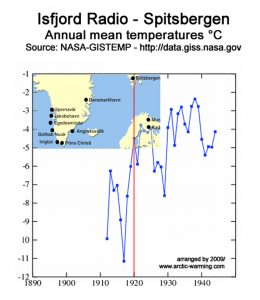All war-churned water flow to the Arctic –
A proof how human has made climate!
Post: 14th April 2018 – Reference: http://www.arctic-heats-up.com/
Washington Post reported on 2 November 1922 based on information relayed by the American consul in Norway to the U.S. State Department in October 1922 and published in the Monthly Weather Review ( Fig. left), with the sensational hint that in 1918 a strong warming began – see last paragraph of extract (Fig. right and below):
on information relayed by the American consul in Norway to the U.S. State Department in October 1922 and published in the Monthly Weather Review ( Fig. left), with the sensational hint that in 1918 a strong warming began – see last paragraph of extract (Fig. right and below):
 In August, 1922, the Norwegian Department of Commerce sent an expedition to Spitzbergen and Bear Island under the leadership of Dr. Adolf Hoel, lecturer on geology at the University of Christiania. Its purpose was to survey and chart the lands adjacent to the Norwegian mines on those islands, take soundings of the adjacent waters, and make other oceanographic investigations.
In August, 1922, the Norwegian Department of Commerce sent an expedition to Spitzbergen and Bear Island under the leadership of Dr. Adolf Hoel, lecturer on geology at the University of Christiania. Its purpose was to survey and chart the lands adjacent to the Norwegian mines on those islands, take soundings of the adjacent waters, and make other oceanographic investigations.
Ice conditions were exceptional. In fact, so little ice has never before been noted. The expedition all but established a record, sailing as far north as 81° 29′ in ice-free water. This is the farthest north ever reached with  modern oceanographic apparatus.
modern oceanographic apparatus.
The character of the waters of the great polar basin has heretofore been practically unknown. Dr. Hoel reports that he made a section of the Gulf Stream at 81° north latitude and took soundings to a depth of 3,100 meters. These show the Gulf Stream very warm, and it could be traced as a surface current till beyond the 81st parallel. The warmth of the waters makes it probable that the favorable ice conditions will continue for some time.
In connection with Dr. Hoel’s report, it is of interest to note the unusually warm summer in Arctic Norway and the observations of Capt. Martin Ingebrigsten, who has sailed the eastern Arctic for 54 years past. He says that he first noted warmer conditions in 1918, that since that time it has steadily gotten warmer, and that to-day the Arctic of that region is not recognizable as the same region of 1868 to 1917.
SOURCE: Associated Press. “Arctic Ocean Getting Warm; Seals Vanish and Icebergs Melt.”
The Washington Post. 2 November 1922 (p. 2).

 A detailed analysis can be read in the book (p.60), “ARCTIC HEATS UP – Spitsbergen 1919-1939” of which an excerpt is given as it follows:
A detailed analysis can be read in the book (p.60), “ARCTIC HEATS UP – Spitsbergen 1919-1939” of which an excerpt is given as it follows:
Spitsbergen as a Heating Spot
If one asks whether the heating-up spot is to be found at Spitsbergen, we would answer: yes. The information supplied sustain this affirmative answer. Nothing demonstrates this better than the data record taken at Spitsbergen since 1912. If one reviews the January/February temperature difference between the winters of 1913/14 and of 1919/20 (ca. + 15oC), or from the winters of 1916-1917 to the winters of 1919-1920 (ca. + 22oC), the results are not only extraordinary, but they reveal that the “shift” took place in 1918, respectively in the winter of 1918/19 (Hesselberg, 1956). This is emphasized by
the comparison between the data recorded from 1912, until WWI ended in November 1918 (ca. – 4.3oC), and thereafter (ca. +3.8oC), including the winter of 1925/26.
In the summer of 1918 the seawater temperatures had already reached unusual values: +7oC to +8oC at the West coast of Spitsbergen (Weikmann, 1942). During the winter of 1918/19 the temperatures varied considerably. There were long periods in November and December 1918 with temperatures close to zero degrees, 4 days with temperatures above zero in November and 7 days in December[38]. In January 1919, the temperatures did not reach -5oC for 14 days, and five days were frost-free. The annual mean (1912-1926) with minus 7.7oC suddenly jumped to an annual average of minus 5.4oC in 1919, representing a plus of 2.3 degree. The corresponding figures provide for January a difference + 8.6oC, which indicates that the sea was able to transfer a lot of heat into the air. However, during February-April 1919, the temperatures were well below the average (ca. -6oC), with a large ice-cover far out into the sea. But that did not affect the significant warming that had started a few months earlier.
CONCLUSION:
Exactly 100 years ago the sea water temperatures at Spitsbergen suddenly reached unusual high values. The connection to the naval war activities in the North Sea and Eastern North Atlantic is obvious. The warming increased over the next two decades and lasted until 1939 until World War II commenced. Two world wars changed climate, but science is neither able nor willing to raise the issue.
